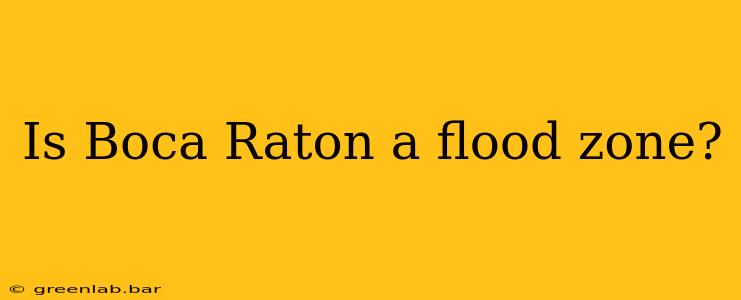Boca Raton, Florida, boasts beautiful beaches and luxurious living, but like many coastal communities, it faces the risk of flooding. Understanding your flood risk is crucial for homeowners, businesses, and anyone planning to live or invest in the area. This article delves into the complexities of flood zones in Boca Raton, providing a comprehensive overview to help you make informed decisions.
Identifying Flood Zones in Boca Raton
Determining if a specific property in Boca Raton lies within a flood zone isn't as simple as a yes or no answer. The Federal Emergency Management Agency (FEMA) uses Flood Insurance Rate Maps (FIRMs) to delineate flood zones. These maps categorize areas based on their probability of experiencing flooding from various sources, including:
- Coastal Flooding: Boca Raton's proximity to the Atlantic Ocean makes it susceptible to storm surge and high tides, particularly during hurricanes and severe storms.
- Riverine Flooding: While less prominent than coastal flooding, rainfall can lead to overflows from canals and waterways within the city.
- Rainfall Flooding: Intense rainfall can overwhelm drainage systems, causing localized flooding in low-lying areas.
To find out if your property is in a flood zone, you need to consult the FEMA Flood Map Service Center. This online tool allows you to enter an address and view the corresponding FIRM panel, which will indicate the flood zone designation (e.g., A, AE, X, etc.). Each designation carries a different level of flood risk.
Understanding Flood Zone Designations
FEMA uses a complex system of letters and numbers to classify flood zones. Some common designations include:
- A Zones: Areas with a 1% annual chance of flooding (100-year floodplain).
- AE Zones: Areas with a 1% annual chance of flooding (100-year floodplain) that are subject to inundation from both rivers and coastal areas.
- X Zones: Areas with minimal to moderate flood risk. They are not considered to be in a Special Flood Hazard Area (SFHA).
- V Zones: Coastal high-velocity flood zones with substantial wave action.
It's crucial to understand that even areas designated as X zones can experience flooding during extreme weather events. Therefore, comprehensive flood risk assessment extends beyond just the FEMA map.
Factors Beyond FEMA Maps: A Deeper Dive into Boca Raton's Flood Risk
While FEMA maps are invaluable, they don't capture the full picture of flood risk in Boca Raton. Several other factors contribute to the overall vulnerability:
- Sea Level Rise: The ongoing rise in sea levels exacerbates the risk of coastal flooding, particularly in low-lying areas. This long-term trend necessitates careful consideration when evaluating properties near the coast.
- Infrastructure: The condition and capacity of drainage systems significantly impact a community's resilience to rainfall flooding. Aging infrastructure or insufficient drainage can increase the severity of flooding in certain areas.
- Development: Increased development can alter natural drainage patterns, potentially increasing flood risk in previously unaffected areas.
Protecting Yourself from Flood Risk in Boca Raton
Regardless of your property's FEMA designation, proactive measures are essential to mitigate flood risk:
- Flood Insurance: Even if you're not in a high-risk zone, consider purchasing flood insurance. It's often not included in standard homeowners' insurance policies. The National Flood Insurance Program (NFIP) offers flood insurance policies, but costs vary based on risk assessment.
- Elevation: Elevating your home's critical systems (electrical panel, furnace, etc.) can reduce damage during flooding.
- Mitigation Measures: Implementing measures like waterproofing basements, installing sump pumps, and creating drainage solutions can significantly reduce the impact of flooding.
Conclusion: A Proactive Approach is Key
Boca Raton's beauty and desirability are undeniable, but understanding and mitigating flood risk is crucial for responsible living and investment. By thoroughly investigating your property's flood zone, considering factors beyond FEMA maps, and taking proactive measures, you can significantly reduce your vulnerability to flooding and protect your assets. Remember, consulting local officials and experts is always recommended for the most accurate and up-to-date information.

